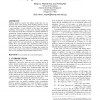Free Online Productivity Tools
i2Speak
i2Symbol
i2OCR
iTex2Img
iWeb2Print
iWeb2Shot
i2Type
iPdf2Split
iPdf2Merge
i2Bopomofo
i2Arabic
i2Style
i2Image
i2PDF
iLatex2Rtf
Sci2ools
KDD
2001
ACM
2001
ACM
Identifying non-actionable association rules
Building predictive models and finding useful rules are two important tasks of data mining. While building predictive models has been well studied, finding useful rules for action still presents a major problem. A main obstacle is that many data mining algorithms often produce too many rules. Existing research has shown that most of the discovered rules are actually redundant or insignificant. Pruning techniques have been developed to remove those spurious and/or insignificant rules. In this paper, we argue that being a significant rule (or a non-redundant rule), however, does not mean that it is a potentially useful rule for action. Many significant rules (unpruned rules) are in fact not actionable. This paper studies this issue and presents an efficient algorithm to identify these non-actionable rules. Experiment results on many real-life datasets show that the number of non-actionable rules is typically quite large. The proposed technique thus enables the user to focus on fewer rul...
| Added | 30 Nov 2009 |
| Updated | 30 Nov 2009 |
| Type | Conference |
| Year | 2001 |
| Where | KDD |
| Authors | Bing Liu, Wynne Hsu, Yiming Ma |
Comments (0)

